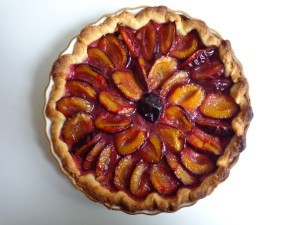Plum tart
Although this recipe calls for blue plums, like the quetsches that appear in eastern France in late summer, it works well with any plum variety. Simply taste the plums before beginning and adjust the amount of sugar you use according to their tartness or sweetness. All of the ingredients should be at room temperature before you begin.
You will need an 8-9 inch (20-22 cm) tart pan – if you’d like to make a larger tart, double the recipe. As for which type of tart pan to choose, it’s best to avoid the two-piece French tart pan that allows you to remove the outer ring after baking, exposing the golden crust. As pretty as that may be, such pans present a risk of leakage with juicy fruits like plums. I would recommended using a normal tart pan with straight sides. If you don’t have one, any one-piece pie pan will do.
As temperatures can vary widely according to the oven, you will need to take a look inside while baking this tart for the first time. If it is baking too quickly (the crust turns brown before the fruit starts to soften), turn down the heat. If it is baking too slowly (nothing much has happened after 15 minutes), turn up the heat.
For the crust (pâte sablée):
1/4 lb. (110 g) unsalted butter
1 egg yolk
1 tbsp. white sugar
1 cup (130 g) plus 2 tbsp. flour
For the filling:
1-1/4 lb. (600 g) blue plums
3-4 tbsp. cassonade or demerara sugar (see note below)
1 tsp. additional butter
In a medium-size bowl, cut the butter into small pieces. Using two knives, cut in the egg yolk, then the sugar, then the flour. This is easily done. Simply hold the knives parallel to each other and cut in opposite directions.
When the butter is well coated with flour, go in with your hands for the final blending. Mix until the dough is no longer sticky and holds together in a ball. You may need to add a bit more flour. Form the ball and let the dough rest for a minute or two. Then pat the dough into your pie pan, taking care to ensure there are no cracks. Place in the fridge to cool for at least 10 minutes.
 While the crust is cooling, rinse the plums, cut them in half and remove the pits. Arrange them in the cooled pie shell in concentric circles, beginning with the outer ring and working inward. If you tilt the plums a little, you can make the circles go prettily in opposite directions, as shown in the photo. Sprinkle the plums with the cassonade, using less sugar for sweet plums, more if they are tart. Dot with butter.
While the crust is cooling, rinse the plums, cut them in half and remove the pits. Arrange them in the cooled pie shell in concentric circles, beginning with the outer ring and working inward. If you tilt the plums a little, you can make the circles go prettily in opposite directions, as shown in the photo. Sprinkle the plums with the cassonade, using less sugar for sweet plums, more if they are tart. Dot with butter.
Preheat your oven to gas mark 5 (375 F, 190 C). Bake for 30-40 minutes. The tart is done when the edges of the plums have begun to brown and the juice is bubbling. Serves 4-6.
Cassonade and demerara are two varieties of raw (unrefined) sugar. More flavorful than refined sugar, they are the best choice for sugaring a pie or tart. They are not equivalent to American-style brown sugar, which contains molasses. If neither cassonade nor demerara is available, use refined white sugar.






Congratulations Meg, your tart is delicious ! The crust (pâte sablée) goes magnificently well with the quetsches.